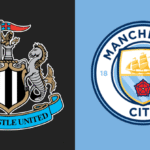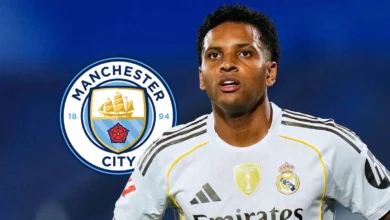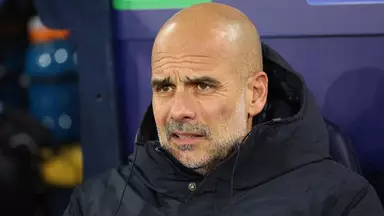Jack Grealish: The Rise, Fall, and Redemption of England’s Most Polarizing Talent

Jack Peter Grealish’s journey from the youth academies of Birmingham to becoming one of the most recognizable faces in English football represents a story of talent, perseverance, and the complex realities of modern football stardom. Born on September 10, 1995, in Birmingham, Grealish’s path to professional football was far from straightforward, marked by early setbacks, personal challenges, and the kind of character-defining moments that separate true champions from mere talented players.
The early years of Grealish’s development were spent in the academy system at Aston Villa, where he joined at the tender age of six. His progression through the youth ranks was meteoric, displaying the kind of natural ability and ball control that coaches dream of discovering. However, it was not just his technical skills that set him apart; it was his fearless approach to the game, his willingness to take risks, and his innate understanding of how to influence matches through individual brilliance.
His breakthrough into Villa’s first team came during the 2013-14 season when he was just 18 years old. The debut against Manchester City in May 2014 marked the beginning of what would become one of the most compelling individual stories in Premier League history. Even in those early appearances, observers could see the raw talent that would eventually make him one of the most sought-after players in European football.
The formative years at Villa Park were crucial in shaping Grealish’s footballing identity. Under various managers and in different tactical systems, he learned to adapt his game while maintaining the core attributes that made him special. His ability to drift between positions, create space in tight areas, and deliver moments of magic when his team needed them most became his trademark. These qualities would later prove invaluable as he navigated the challenges of top-level football.
The Aston Villa Years: From Relegation to Resurrection
The period between 2014 and 2021 represents the most formative chapter in Jack Grealish’s career, characterized by the extreme highs and lows that would define his relationship with football and establish his reputation as one of the Premier League’s most captivating performers. During this time, he experienced relegation to the Championship, promotion back to the Premier League, and ultimately emerged as Villa’s captain and talisman.
The 2015-16 season proved to be a watershed moment for both Grealish and Aston Villa. The club’s relegation to the Championship was a devastating blow, but it provided the young midfielder with an opportunity to mature both as a player and as a person. Playing in the Championship, often considered one of the most physically demanding leagues in world football, taught him lessons about resilience, consistency, and leadership that would serve him well throughout his career.
During Villa’s time in the Championship, Grealish’s performances were nothing short of exceptional. He became the focal point of their attacking play, demonstrating remarkable consistency and an ability to perform under pressure. His 41 appearances during the 2017-18 season, contributing 6 goals and 8 assists, were instrumental in Villa’s push for promotion. However, it was not just his statistics that impressed; it was his leadership qualities and his ability to inspire his teammates during crucial moments.
The playoff final victory over Derby County in 2018 stands as one of the defining moments of Grealish’s career. His performance at Wembley Stadium, where he provided the assist for the winning goal, demonstrated his ability to perform on the biggest stage. The image of him celebrating with the Villa fans after securing promotion remains one of the most iconic moments in recent Villa history and perfectly encapsulated his connection with the club and its supporters.
Upon Villa’s return to the Premier League, Grealish’s evolution as a player accelerated dramatically. The 2019-20 season saw him establish himself as one of the league’s most creative forces, registering 8 goals and 6 assists in 36 appearances. His performances during this campaign, particularly in crucial matches against top-six opposition, announced his arrival as a genuine Premier League star and attracted the attention of England manager Gareth Southgate.
The 2020-21 season represented the pinnacle of Grealish’s time at Villa Park. His statistics of 6 goals and 12 assists in 26 Premier League appearances tell only part of the story. He was involved in more goals per 90 minutes than any other player in the league, and his ability to create chances from seemingly impossible positions made him one of the most feared attacking players in European football. His performances during this period were so impressive that they prompted Manchester City to make him their primary transfer target.
The Manchester City Chapter: Expectations vs Reality
The summer of 2021 marked a seismic shift in Jack Grealish’s career when Manchester City activated his £100 million release clause, making him the most expensive player in British football history. The transfer represented the culmination of years of speculation and established him as one of the premier talents in world football. However, the transition from Villa Park to the Etihad Stadium would prove to be far more challenging than anyone anticipated.
Pep Guardiola’s tactical system at Manchester City is renowned for its complexity and precision. Players are expected to operate within strict positional parameters while maintaining the technical excellence required to execute intricate passing patterns and movement sequences. For a player like Grealish, whose greatest strengths lay in his improvisational skills and ability to create something from nothing, adapting to such a regimented system presented significant challenges.
The first season at City was marked by flashes of brilliance interspersed with periods of adjustment. Grealish’s 3 goals and 3 assists in 26 Premier League appearances represented a significant drop from his Villa output, but they failed to capture the nuanced role he was asked to play within Guardiola’s system. His contribution to City’s possession-based approach, his ability to retain the ball under pressure, and his work rate in defensive phases demonstrated his commitment to adapting his game.
The 2022-23 season brought improved returns, with Grealish playing a crucial role in City’s treble-winning campaign. His 5 goals and 7 assists across all competitions were complemented by his increased understanding of his teammates’ movements and his growing confidence within the tactical framework. The Champions League final against Inter Milan showcased his ability to perform in the most pressurized environments, with his pace and directness causing problems for the Italian defense.
However, the 2023-24 campaign marked a concerning decline in Grealish’s influence and playing time. Competition for places in City’s attacking positions intensified, and his unique skill set began to appear less essential to Guardiola’s tactical plans. The emergence of other players and the manager’s preference for different tactical approaches meant that Grealish found himself increasingly relegated to a substitute role.
International Career: The Weight of Expectation
Jack Grealish’s international career with England represents one of the most intriguing subplots in his professional journey. His decision to represent England over the Republic of Ireland, for whom he had played at youth level, generated considerable controversy and established him as a polarizing figure before he had even earned his first senior cap.
The path to his England debut was fraught with complications. Despite his outstanding performances for Aston Villa, particularly during their promotion campaign and early Premier League seasons, Grealish found himself overlooked by successive England managers. The competition for places in England’s attacking midfield positions was fierce, with established players like Raheem Sterling, Marcus Rashford, and Jadon Sancho seemingly ahead of him in the pecking order.
His international breakthrough finally came in September 2020 when Gareth Southgate included him in the England squad for Nations League matches against Iceland and Denmark. His debut against Denmark marked the beginning of what would become a complex relationship with the international setup. While his technical ability was never in question, questions remained about how his individualistic style would fit within England’s tactical framework.
The 2021 European Championship represented the pinnacle of Grealish’s international career to date. Despite starting the tournament as a substitute, his impact from the bench in crucial moments demonstrated his value to the squad. His ability to change the tempo of games, create space for teammates, and provide moments of individual brilliance made him a valuable asset during England’s run to the final.
The World Cup in Qatar presented another opportunity for Grealish to establish himself as a key player for England. His performances during the tournament were solid if unspectacular, contributing to England’s quarter-final appearance. However, the competition for places in England’s attacking positions remained intense, and his role within the squad continued to be that of a valuable squad player rather than an automatic starter.
The Psychology of Pressure and Performance
Understanding Jack Grealish’s career requires an examination of the psychological pressures that come with being one of the most scrutinized players in English football. The combination of his distinctive appearance, confident personality, and high-profile lifestyle has made him a constant subject of media attention, both positive and negative.
The pressure of his £100 million price tag at Manchester City cannot be understated. Few players in football history have carried such a significant financial burden, and the expectation to justify such an investment has undoubtedly influenced his performances and decision-making on the pitch. The constant scrutiny of his every touch, pass, and movement has created an environment where mistakes are amplified and successes are often viewed as merely meeting expectations rather than exceeding them.
His relationship with the media has been complex throughout his career. While his charismatic personality and willingness to engage with journalists has made him a popular figure for interviews and features, it has also led to increased scrutiny of his personal life. The balance between maintaining his authentic personality and managing the expectations of being a role model has been a constant challenge.
The psychological impact of transitioning from being the star player at Aston Villa to being one of many talented players at Manchester City should not be underestimated. At Villa, entire tactical systems were built around his strengths, and he was given the freedom to express himself without significant tactical constraints. At City, he has had to learn to sublimate his individual desires for the collective good of the team, a transition that has required significant mental adaptation.
Technical Analysis: The Art of Modern Wing Play
Jack Grealish’s technical abilities represent a fascinating case study in modern wing play and the evolution of attacking midfield roles in contemporary football. His skill set combines traditional wing play attributes with modern tactical intelligence, creating a unique player profile that has both enhanced and complicated his career trajectory.
His dribbling ability remains his most distinctive attribute. The low center of gravity, combined with exceptional close control and the ability to change direction at pace, makes him one of the most difficult players to defend against in one-on-one situations. His success rate in take-ons throughout his career has consistently ranked among the highest in whatever league he has played in, demonstrating his effectiveness in beating defenders.
The tactical intelligence displayed by Grealish often goes unnoticed by casual observers but is highly valued by coaches and tactical analysts. His ability to recognize space, time his runs, and position himself to receive passes in dangerous areas demonstrates a sophisticated understanding of positional play. This intelligence has been crucial in his adaptation to different tactical systems throughout his career.
His passing ability, while sometimes overshadowed by his dribbling skills, represents another crucial component of his technical arsenal. The range of passes he can execute, from simple possession-maintaining balls to defense-splitting through passes, makes him a valuable creative outlet for any team. His assist numbers throughout his career reflect his ability to create chances for teammates, even when he is not directly involved in the final action.
The Cultural Impact Beyond Football
Jack Grealish’s influence extends far beyond the football pitch, establishing him as a cultural icon whose impact resonates throughout British society. His distinctive style, both in terms of his appearance and his approach to the game, has made him a figure of fascination for fans, media, and cultural commentators alike.
His fashion choices and personal style have influenced a generation of young footballers and fans. The signature headband, the distinctive socks, and his overall aesthetic have become instantly recognizable symbols that transcend football. His influence on youth culture, particularly in terms of fashion and attitude, demonstrates the power of football personalities to shape broader cultural trends.
The commercial impact of Grealish’s brand has been substantial. His marketability has made him one of the most sought-after players for endorsement deals, with major brands recognizing his appeal to younger demographics. His social media presence, carefully managed to maintain authenticity while promoting various partnerships, has set new standards for how modern footballers engage with their audiences.
His role as a representative of Birmingham and the broader West Midlands region has been significant. For many young people from working-class backgrounds, Grealish represents the possibility of achieving success while maintaining authenticity and connection to their roots. His journey from local academy player to international star provides inspiration for countless young players pursuing their own football dreams.
The Evolution of Playing Style
Throughout his career, Jack Grealish’s playing style has undergone significant evolution, reflecting his adaptation to different tactical systems, levels of competition, and personal maturation. Understanding this evolution provides insight into both his versatility as a player and the challenges he has faced in maximizing his potential.
During his early years at Aston Villa, Grealish’s style was characterized by individual brilliance and a willingness to take risks. He operated with considerable freedom, often dropping deep to collect the ball before driving forward and creating opportunities through individual skill. This approach was highly effective in the Championship and during Villa’s early Premier League seasons, where his ability to create something from nothing was crucial to the team’s success.
The transition to Manchester City required significant adjustments to his natural playing style. Guardiola’s system demanded greater tactical discipline, more precise positioning, and a different approach to risk-taking. Instead of the free-flowing, improvisational style that had made him famous, Grealish had to learn to operate within more structured patterns of play while still contributing his unique abilities.
His role in the England setup has required yet another adaptation. International football’s different tempo and tactical requirements have meant that Grealish has had to develop new aspects of his game while maintaining the core attributes that made him successful. His ability to impact games from the bench has become particularly valuable, demonstrating his tactical intelligence and adaptability.
Future Prospects and Legacy Considerations
As Jack Grealish approaches his peak years as a footballer, questions about his future and ultimate legacy in the game become increasingly relevant. At 29, he is at an age where many players begin to hit their prime, but his recent struggles for consistency and playing time have raised questions about his ability to fulfill his enormous potential.
The immediate future likely holds several possible scenarios for Grealish. A move away from Manchester City could provide the regular playing time and tactical freedom necessary to rediscover his best form. Alternatively, a renewed commitment to adapting his game to Guardiola’s system could see him emerge as a key player in City’s continued pursuit of domestic and European success.
His international career remains another area of potential growth. With England possessing one of the most talented squads in world football, Grealish’s ability to establish himself as a regular starter could define his legacy with the national team. Major tournaments provide opportunities for players to cement their reputations, and future competitions could be crucial for his international standing.
The broader question of Grealish’s legacy involves his impact on English football and his role in inspiring future generations of players. His journey from academy player to international star, complete with its various challenges and setbacks, provides a compelling narrative about perseverance and the importance of maintaining belief in one’s abilities.
Conclusion: The Continuing Story
Jack Grealish’s story is far from over. At 29, he remains one of the most technically gifted players in world football, with the potential to achieve great things in the years ahead. His journey from Birmingham academy prospect to £100 million player represents one of the most fascinating career trajectories in modern football, complete with triumphs, setbacks, and the ongoing pursuit of excellence.
The challenges he has faced at Manchester City, while frustrating for both player and supporters, may ultimately prove to be crucial in his development. The experience of adapting to different tactical systems, competing with world-class players, and learning to succeed in various roles could make him a more complete player and better prepared for future challenges.
His impact on English football extends beyond his individual achievements. As a player who has consistently demonstrated the importance of technical ability, creativity, and individual expression in an increasingly systematic game, he has helped maintain the tradition of English football’s most entertaining performers. His influence on young players, both in terms of style and approach, ensures that his legacy will continue long after his playing career ends.
The next chapter of Jack Grealish’s career will be crucial in determining his ultimate place in football history. Whether he rediscovers his best form at Manchester City, finds success elsewhere, or continues to be a valuable squad player for both club and country, his story remains one of the most compelling in contemporary football. For a player who has already achieved so much while facing significant challenges, the future holds the promise of even greater achievements and the possibility of writing the perfect ending to an already remarkable career.














